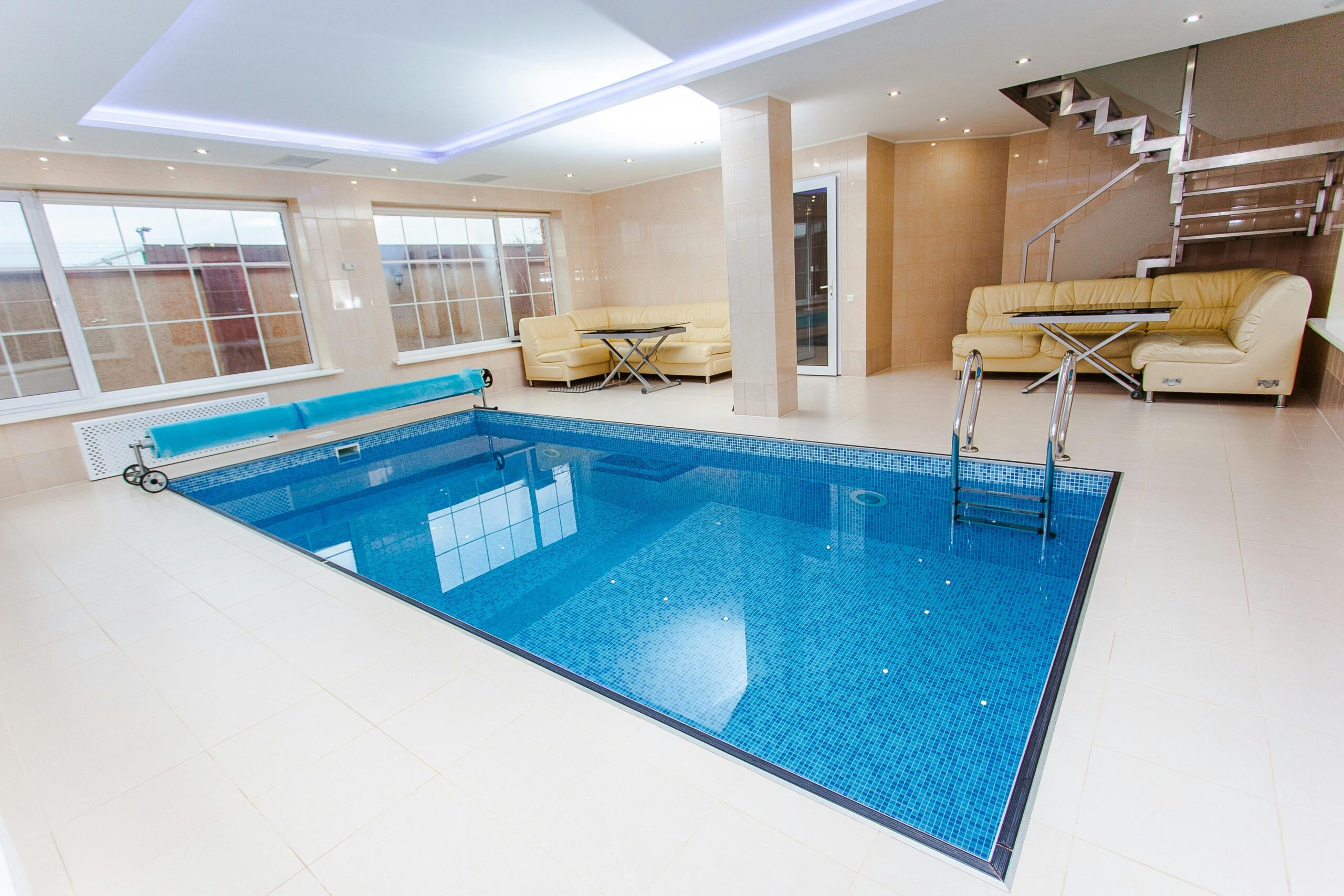Introduction to Indoor Swimming Pool Design

What Makes Indoor Pools Unique?
There is a significant difference between indoor and outdoor pools, as indoor pools are typically constructed within a controlled environment, usually inside a house, in the basement, or even in a dedicated or custom-built enclosure. Unlike the outdoor pools, they are not affected by weather-related activities like rain, snow, or extreme temperatures, hence they can be utilized at any time of the year. The controlled environment creates a controlled water temperature, air quality, and comfort level, creating once again a truly personal swim experience.
Benefits of an Indoor Swimming Pool
It is not only a luxury amenity of having an indoor swimming pool design ideas, but it is also a long-term investment that will positively impact health, lifestyle, and even property value. Homeowners are given the quiet environment of swimming undisturbed in a personal pool without intrudes. Families find it convenient to have a safe swimming area to take their children, and fitness enthusiasts can exercise in any season. Moreover, indoor pools tend to be less intensive to clean than those having an outdoor location since the latter is exposed to leaves, dust, or insects. Hand in hand with the potential of adding luxury and sophistication to a home that an indoor pool offers is the value it adds when it comes to real estate.
Basics of Indoor Swimming Pool Design Ideas
Space and Layout Considerations
The initial step in the indoor pool design is knowledge of the space available. High-walled pool rooms with high ceilings and plenty of natural light are preferable in large properties, and smaller homes can consider the use of compact plunge pools or resistance pools. The arrangement in this case must be able to balance swimming space, reception areas, and safety. Paths must be broad, and the material should be slip-resistant. Always remember the connection of the pool to other parts of the house, such as the seamless connection to a gym, living rooms, or wellness centers.
Choosing the Right Pool Size and Shape
Shape and size are directed by use. Providing it is fitness-oriented, the pool should be long and narrow. Families will be able to favor broader models with low depths in which kids may play. Shapes vary between typical conventions of rectangles and curves or free forms of pools, depending on tastes as well as in accordance with the area available. In the case of basements or smaller-sized rooms, plunge pools or square pools are space-saving features that provide a relaxing experience of the water.
Essential Features (Ventilation, Heating, Lighting)
Indoor pools require paying special attention to the technical details. Ventilation is very important to manage humidity and avoid damage due to mold or structural damage. Heating systems not only keep the water warm but also provide a comfortable air environment. Lighting will serve both a functional and aesthetic purpose: bright task lights will be used to help create safer conditions, whereas underwater LEDs and ambient lights on the ceiling will be used to create a better atmosphere.

Popular Indoor Swimming Pool Design Styles
Modern Minimalist Indoor Pool
Small pools are minimalistic. Straight lines, shades of grey, and simple designs act to produce a modern, sleek appearance. These pools consist of simple rectangular shapes, glass, and concealed light fittings to create a relaxed, subtle atmosphere of style.
Luxury Spa-Inspired Indoor Pool
Those in need of a wellness vacation in their own backyard can choose to have the spa-like pools that merge swimming with hydrotherapy. Such additions as inbuilt hot tubs, massage jets, and sauna rooms form a total relaxation unit. Warm colours, natural stone, and the appropriate use of lighting create a spa-like environment.
Glass-Enclosed Indoor Pool
Glass-walled pools or glass conservatories extend ample sunlight into the pool area, but the pool is encased in a room. The design softens the distinction between the internal and external living by letting the swimmers enjoy the outside landscape or garden even when it is winter.
Family-Friendly Indoor Pool Design
Safety and fun are the main factors of family pools. The shallow areas, safety flooring, and covers provide safety, whereas the high-flying extras, such as the slide, waterfall, and fountain, offer fun. To make such areas friendlier to children, these designs tend to use warm colours and bright light.
Underground or Basement Indoor Pool
Basement pools are ideal when it comes to space maximisation and allow you to have your privacy. They do not hear noise and need innovative illumination, and sometimes it makes it even cosier and intimate. They can be well designed to offer a hidden beauty in the house.
Materials and Finishes for Indoor Pools

Best Tile and Flooring Options
Best Tile and Floor Options was established in 1995 as Ability Tile and Flooring. Best Tile and Floor Options is a member of the Association of Tile and Concrete Producers. It was in operation from 2004 to 2005 from its location in Kijabi. It deals in ceramic tiles and flooring. The tiles range between 50 and 5000 and 50 and 4000 square metres.
Walls, Ceilings, and Surroundings
Walls and ceilings should be resistant to evil and waterproof, and should be insulated to prevent humidity. Coloured paints, panelling, or stone walls may establish the tone within the room. The ceilings may have timber beams to give a rustic impression or smooth finishes to give a modern appearance. Noise control can be imposed by the inclusion of acoustic panels to reduce noise levels in confined spaces.
Lighting and Ambiance Ideas
Lighting will turn the space around the pool into an experience. LEDs of blue or green give an underwater effect to relax, and wall lights are used to bring out the features of the architectural structure. Skylights or glass ceilings make the space bathed in natural light in the daytime, with dimmable lights providing a calming light at night.
Real-World Applications of Indoor Swimming Pool Design Ideas
Residential Indoor Pool Examples
In residential homes, the pool is usually incorporated in the basement, a sunroom, or an extension. Small plunge pools are fashionable in the city, whereas more expansive properties include full spa facilities. Most individuals are putting in a swimming pool along with a gym or lounge facility in their homes to form a multi-purpose health centre.
Commercial and Hotel Indoor Pools
Indoor pools are a luxurious accommodation feature of hotels and resorts. Designs tend to be grandiose, featuring infinity edges, large ceilings, and finishes that are stylish. Rooftop enclosures with glass panels that thin out are utilised to create a dramatic effect in a few business places.
Wellness and Fitness Centers
Gyms and spas ensure that pools are designed with a purpose in mind, be it lap pools to work out, therapy pools to rehabilitate, or spa pools to relax. These are areas that are highly focused on toughness, simple cleaning, and good ventilation.
Cost and Budget Considerations
Average Indoor Pool Costs
Indoor pools have a wide range of expenses. Homeowners will pay an average of $70,000 to $200,000, depending on the size of the building and the location, and the complexity that is involved in the design. Luxury features such as saunas, glass enclosures, or heating systems can make a big difference in the costs.
Factors That Affect Pricing
- The size of the pool and depth
- Use of materials and finishes selected
- Architectural/Structural changes (e.g., basement excavation)
- Ventilating and heating systems
- Additionally, just like spas, waterfalls, or lights
Cost-Saving Tips for Indoor Pools
- Select low-energy-consuming heating and dehumidifiers.
- Use standard sizes rather than the custom shapes.
- Employ materials that are durable and, at the same time, low-maintenance.
- Consider the plan of multipurpose spaces to create maximum value.
Maintenance and Safety Tips
Humidity and Ventilation Management
The greatest problem with indoor pools is humidity. Dehumidifiers and the use of a proper airflow system are vital to prevent condensation, mould, and structural damage. Checks are also done regularly to maintain the air as comfortable and safe.
Cleaning and Water Treatment
Indoor pools need an equal amount of chemical adjustments, filtration, and water testing as outdoor pools. Fully automated cleaning systems can save on manpower and keep the water as clear as possible.
Safety Features and Pool Covers
Slip-resistant floors, railings, and pool covers are some of the safety measures to be taken into account. Automatic versatile covers will retain heat, reduce humidity, and, in addition, keep the pool secure when it is not in use. Installation of alarms or childproof barriers will provide one more level of safety to the family.

FAQs
How much space do I need for an indoor pool?
Rectangular pools that need to be 10 x 20 feet may take up small spaces to fit the plunge pools, whereas lap pools require a minimum of 40 feet in length. The size of the available space shall define whether it is possible to construct a full recreational swimming pool or a compact relaxation swimming pool.
Are indoor pools more expensive than outdoor pools?
Yes. Indoor pools tend to have higher costs as a result of ventilation and insulation requirements and heating facilities. Nevertheless, they are simpler to care for and can be utilised throughout the year, and this goes a long way to counterbalance the investment in the medium-long term.
Can I build an indoor pool in my basement?
That is alright, but it needs structural analysis. Ceiling height, ventilation, waterproofing, and access have to be well laid out. Large mansions have been able to incorporate basement pools in their designs to embrace privacy and save space.
Conclusion – Choosing the Best Indoor Swimming Pool Design
An indoor swimming pool can be an impressive feature of any property, giving all-year-round use, privacy, and pampering. The right design depends on your lifestyle, of course, whether you desire a sleek minimalist pool, a spa-like retreat, or family family-friendly play space. If you take into account thoroughly the space, budget, materials, and maintenance, you can then make a pool that not only absorbs practical needs but also becomes the focal point of your abode. An indoor swimming pool may turn out to be a long-lasting reality with professional planning.

